Assessment of Three Satellite-Derived Surface Downward Longwave Radiation Products in Polar Regions
Abstract
:1. Introduction
2. Materials and Methods
2.1. Study Area
2.2. Satellite Radiation Products
2.2.1. ISCCP-FD
2.2.2. GEWEX-SRB
2.2.3. CERES-SYN
2.2.4. Treatment of Cloud in Three Products
2.3. Ground Measurements
2.4. Validation Method
3. Results
3.1. Validation Results at All Sites
3.2. Differences in DLRs of Arctic and Antarctic
3.3. DLR Varying with Seasons
3.4. Cloud Radiation Forcing of DLR Products
4. Discussion on Error Sources
4.1. Uncertainty of Atmospheric Parameters
4.2. Influence of Cloud Parameters
4.3. Influence of Elevation
4.4. Influence of Spatial Resolution
5. Conclusions
- (1)
- CERES-SYN DLR has the best performance (lowest RMSE and highest R2) in polar regions, CERES-SYN has a poorer result, and ISCCP-FD has the worst result. At these sites, RMSE is from 22.3 to 35.2 W/m2 for CERES-SYN, is 29.3 to 44.1 W/m2 for GEWEX-SRB and is 27.5 to 79.1 W/m2 for ISCCP-FD. The overall RMSEs at all polar sites are 35.8, 40.5, and 26.9 W/m2 for GEWEX-SRB, ISCCP-FD, and CERES-SYN. Both GEWEX-SRB and CERES-SYN underestimate DLRs at most sites, while ISCCP-FD overestimates DLRs at most sites. ISCCP-FD has a very large error at the SPO site that has a large altitude and latitude. Three products have very poor results at GVN, SYO, and ALE.
- (2)
- The results in the Arctic are better than those in the Antarctic. The DLR RMSEs of GEWEX-SRB, ISCCP-FD, and CERES-SYN are 34.7 W/m2 (13.6%), 36.0 W/m2 (14.2%), and 26.2 W/m2 (10.3%) in the Arctic and are 38.8 W/m2 (24.3%) and 54.8 W/m2 (34.2%), and 28.6 W/m2 (17.9%) in the Antarctic. CERES-SYN has good accuracy both in the Antarctic and Arctic but overestimates DLRs by 0 to 50 W/m2 when observed DLR larger than 220 W/m2 in the Antarctic. R2 from the products becomes larger at smaller latitudes both in the Arctic and Antarctic in general, though a few sites do not obey the trend strictly. For similar latitudes, the R2 of Antarctic sites is smaller than those of Arctic sites.
- (3)
- The ground-observed DLRs show no obvious or slight seasonal variation in the Antarctic and have obvious seasonal variation in the Arctic. CERES-SYN and GEWEX-SRB DLR products can capture most of the DLR seasonal variation in both the Antarctic and Arctic, except for certain months and the DLR anomaly. ISCCP-FD overestimates the month mean DLR in every season in the Antarctic, underestimates DLR in summer, and overestimated in other seasons in the Arctic.
- (4)
- Though both ISCCP-FD and GEWEX-SRB use ISCCP cloud product, their cloud fraction and FDLR are different. The sites at smaller latitudes tend to have larger year mean values of cloud fraction and FDLR than those at larger latitudes. ISCCP has larger cloud fraction and larger cloud radiation forcing at most sites than GEWEX-SRB. The year mean values of cloud fraction and FDLR from ISCCP-FD is 0.01 to 0.08 larger and 3.0 to 7.6 larger than those from GEWEX-SRB at the sites excluding SPO, BAR and ALE.
- (5)
- The most important factors that influence DLR accuracy of satellite products are the uncertainties of the input atmospheric parameters and cloud parameters, elevation and spatial resolution also have negligible influence on DLR validation. According to the analysis at SPO sites, the errors in Ta and PW causes DLR error up to 57.4 W/m2 and 8.4 W/m2, respectively, the error of 0.1 in cloud fraction cause about 6 W/m2 error in DLR on average, and a variation of 0.5 km in cloud base height leads to a DLR variation 4 to 5 W/m2. CERES-SYN uses MODIS cloud data, which has higher spatial resolution and quality than the NOAA/AVHRR derived cloud data used by GEWEX-SRB and the ISCCP-FD, while ISCCP-FD has the coarsest spatial resolution and uses TOVS profile with the most coarse temporal and vertical resolution, this is an important reason that CERES-SYN DLR has the best performance and ISCCP-FD has the worst result in polar regions.
Author Contributions
Funding
Institutional Review Board Statement
Informed Consent Statement
Data Availability Statement
Conflicts of Interest
Appendix A
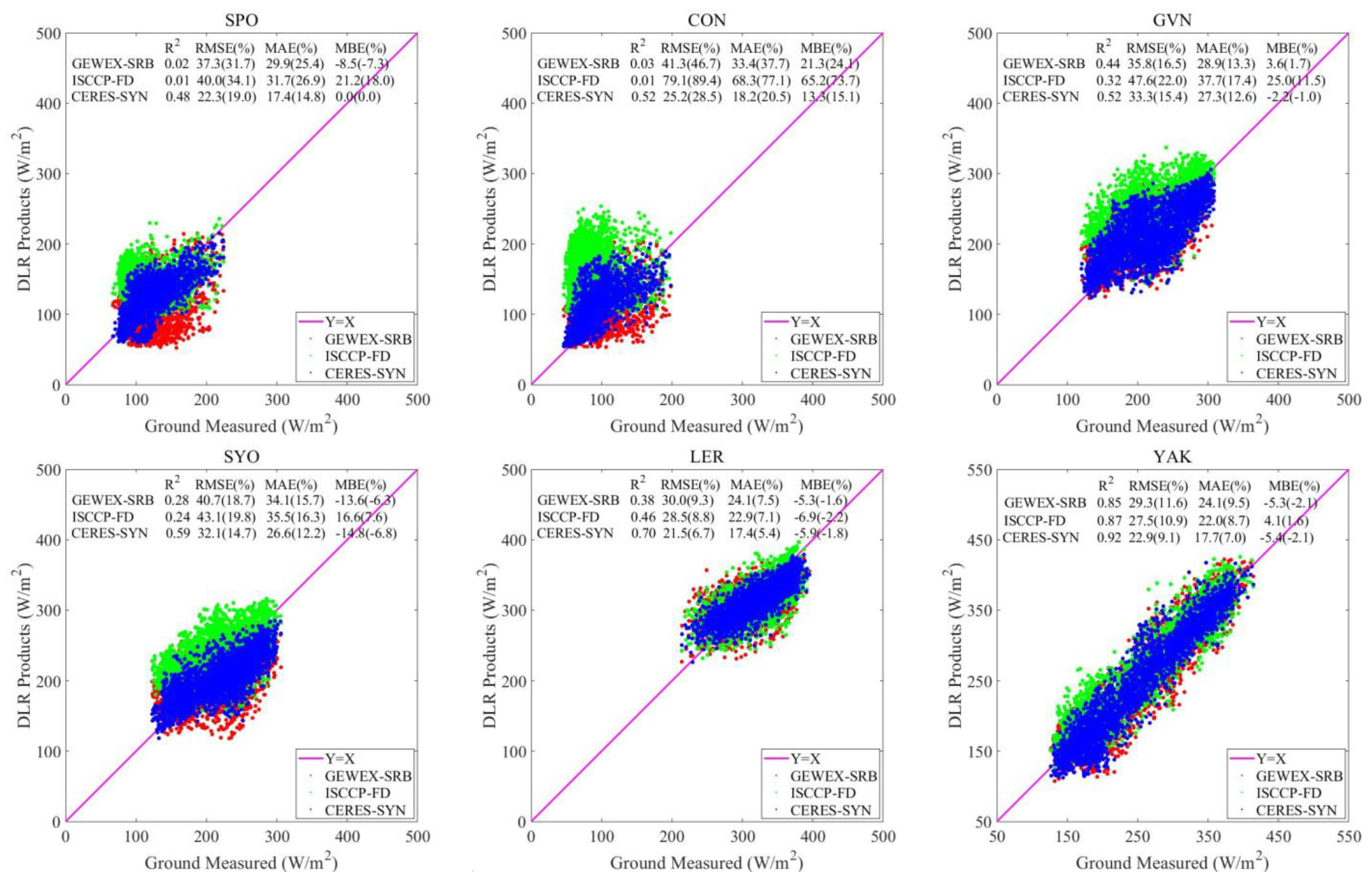
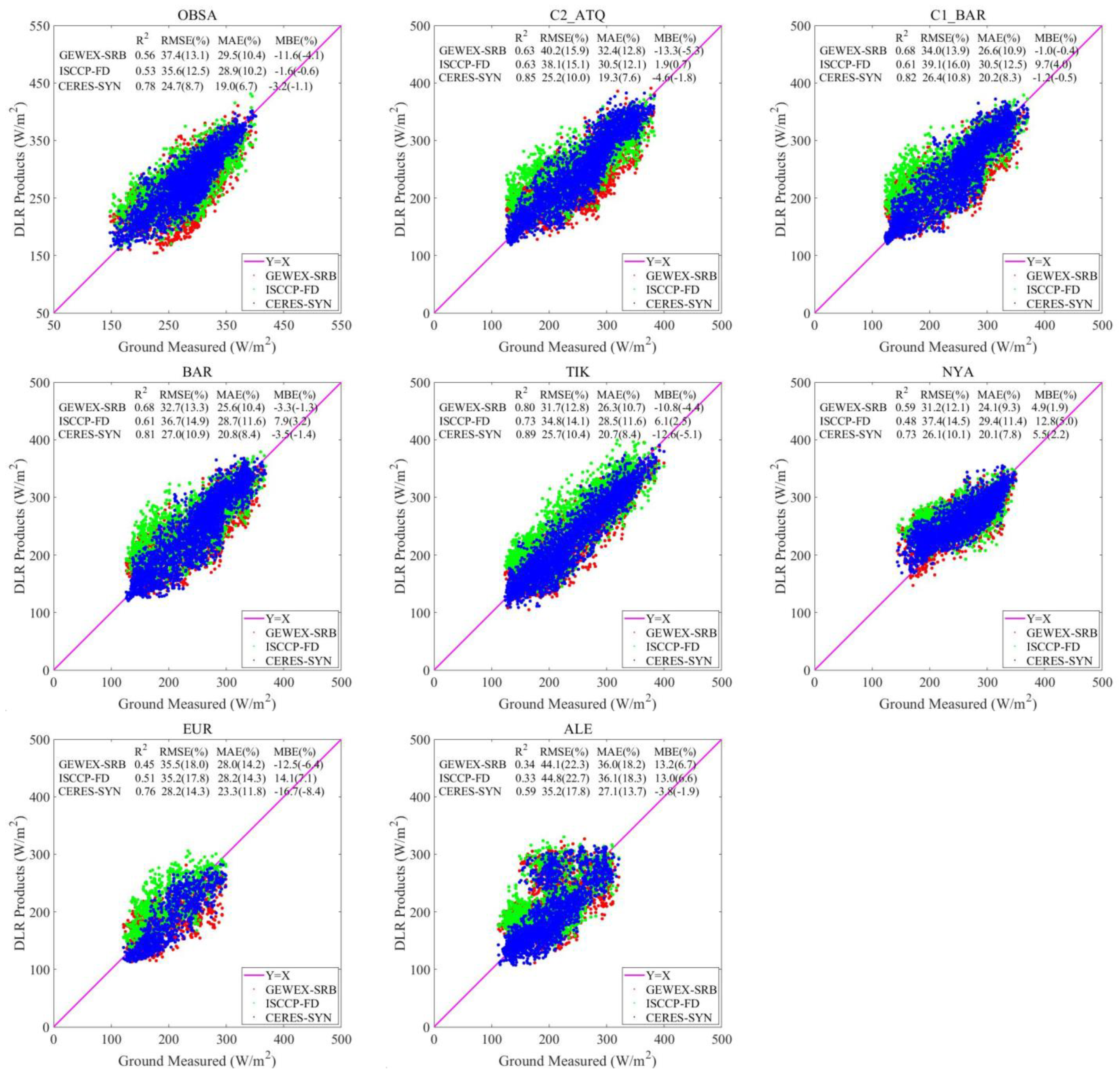
References
- Nussbaumer, E.A.; Pinker, R.T. Estimating surface long-wave radiative fluxes at global scale. Q. J. R. Meteor. Soc. 2012, 138, 1083–1093. [Google Scholar] [CrossRef]
- Trigon, I.F.; Barroso, C.; Viterbo, P.; Freitas, S.C.; Monteiro, I.T. Estimation of downward long-wave radiation at the surface combining remotely sensed data and NWP data. J. Geophys. Res. 2010, 115, D24118. [Google Scholar]
- Feng, C.; Zhang, X.; Wei, Y.; Zhang, W.; Hou, N.; Xu, J.; Yang, S.; Xie, X.; Jiang, B. Estimation of Long-Term Surface Downward Longwave Radiation over the Global Land from 2000 to 2018. Remote Sens. 2021, 13, 1848. [Google Scholar] [CrossRef]
- Kratz, D.P.; Gupta, S.K.; Wilber, A.C.; Sothcott, V.E. Validation of the CERES Edition 2B Surface-Only Flux Algorithms. J. Appl. Meteorol. Clim. 2010, 49, 164–180. [Google Scholar] [CrossRef]
- Guo, Y.M.; Cheng, J.; Liang, S.L. Comprehensive assessment of parameterization methods for estimating clear-sky surface downward longwave radiation. Theor. Appl. Climatol. 2018, 135, 1045–1058. [Google Scholar] [CrossRef]
- Jiao, Z.H.; Mu, X.H. Global validation of clear-sky models for retrieving land-surface downward longwave radiation from MODIS data. Remote Sens. Environ. 2022, 271, 112903. [Google Scholar] [CrossRef]
- Li, Z.L.; Tang, R.; Wan, Z.; Bi, Y.; Zhou, C.; Tang, B. A review of current methodologies for regional evapotranspiration estimation from remotely sensed data. Sensors. 2009, 9, 3801–3853. [Google Scholar] [CrossRef]
- Tang, B.; Li, Z.L.; Zhang, R. A direct method for estimating net surface shortwave radiation from MODIS data. Remote Sens. Environ. 2006, 103, 115–126. [Google Scholar] [CrossRef]
- Tang, R.; Li, Z.L.; Tang, B. An application of the Ts-VI triangle method with enhanced edges determination for evapotranspiration estimation from MODIS data in arid and semi-arid regions: Implementation and validation. Remote Sens. Environ. 2010, 114, 540–551. [Google Scholar] [CrossRef]
- Gupta, S.K.; Ritchey, N.A.; Wilber, A.C.; Whitlock, C.H. A Climatology of Surface Radiation Budget Derived from Satellite Data. J. Clim. 1999, 12, 2691–2710. [Google Scholar] [CrossRef]
- Hollmann, R.; Mueller, R.W.; Gratzki, A. CM-SAF surface radiation budget: First results with AVHRR data. Adv. Space Res. 2006, 37, 2166–2171. [Google Scholar] [CrossRef]
- Gorbarenko, E.V. A possibility of determination of earth surface radiation budget from calculated and satellite data. Russ. Meteorol. Hydrol. 2017, 42, 745–752. [Google Scholar] [CrossRef]
- Li, W.; Letu, H.; Chen, H.; Shang, H. Estimation of surface solar radiation using MODIS satellite data and rstar model. Remote Sens. Technol. Appl. 2017, 32, 643–650. [Google Scholar]
- Karlsson, K.G.; Anttila, K.; Trentmann, J.; Stengel, M.; Meirink, J.F.; Devasthale, A.; Hanschmann, T.; Kothe, S.; Jääskeläinen, E.; Sedlar, J.; et al. CLARA-A2: The second edition of the CM SAF cloud and radiation data record from 34 years of global AVHRR data. Atmos. Chem. Phys. 2017, 17, 5809–5828. [Google Scholar] [CrossRef]
- Liang, S.; Cheng, J.; Jia, K.; Jiang, B.; Liu, Q.; Xiao, Z.; Yao, Y.; Yuan, W.; Zhang, X.; Zhao, X. The Global Land Surface Satellite (GLASS) Product Suite. Bull. Am. Meteorol. Soc. 2021, 102, E323–E337. [Google Scholar] [CrossRef]
- Cho, H.K.; Kim, J.; Jung, Y.; Lee, Y.G. Recent Changes in Downward Longwave Radiation at King Sejong Station, Antarctica. J. Clim. 2008, 21, 5764–5776. [Google Scholar] [CrossRef]
- Yu, Y.Q.; Zhi, H.; Wang, B.; Wan, H. Coupled Model Simulations of Climate Changes in the 20th Century and Beyond. Adv. Atmos. Sci. 2008, 25, 641–654. [Google Scholar] [CrossRef]
- Carroll, J.J.; Fitch, B.W. Effects of solar elevation and cloudiness on snow albedo at the South Pole. J. Geophys. Res. Ocean. 1981, 86, 5271–5276. [Google Scholar] [CrossRef]
- Wiscombe, W.J.; Warren, S.G. A Model for the Spectral Albedo of Snow. I: Pure Snow. J. Atmos. Sci. 1980, 37, 2712–2733. [Google Scholar] [CrossRef]
- Broeke, M.V.D.; Reijmer, C.; Wal, R.V.D. Surface radiation balance in Antarctica as measured with automatic weather stations. J. Geophys. Res. Atmos. 2004, 109, D09103. [Google Scholar]
- Dutton, E.G.; Stone, R.S.; Nelson, D.W.; Mendonca, B.G. Recent Interannual Variations in Solar Radiation, Cloudiness, and Surface Temperature at the South Pole. J. Clim. 1991, 4, 848–858. [Google Scholar] [CrossRef]
- Stanhill, G.; Cohen, S. Recent Changes in Solar Irradiance in Antarctica*. J. Clim. 2010, 10, 2078–2086. [Google Scholar] [CrossRef]
- Briegleb, B.P.; Bromwich, D.H. Polar radiation budgets of the NCAR CCM3. J. Clim. 1998, 11, 1246–1269. [Google Scholar] [CrossRef]
- Hegyi, B.M.; Taylor, P.C. The regional influence of the Arctic Oscillation and Arctic Dipole on the wintertime Arctic surface radiation budget and sea ice growth. Geophys. Res. Lett. 2017, 44, 4341–4350. [Google Scholar] [CrossRef]
- Taylor, P.C.; Cai, M.; Hu, A.X.; Meehl, J.; Washington, W.; Zhang, G.J. A decomposition of feedback contributions to polar warming amplification. J. Clim. 2013, 26, 7023–7043. [Google Scholar] [CrossRef]
- Zhang, Y.C.; Rossow, W.B.; Lacis, A.A.; Oinas, V.; Mishchenko, M.I. Calculation of radiative fluxes from the surface to top of atmosphere based on ISCCP and other global data sets: Refinements of the radiative transfer model and the input data. J. Geophys. Res. 2004, 109, D19105. [Google Scholar] [CrossRef]
- Xia, X.A.; Wang, P.C.; Chen, H.B.; Liang, F. Analysis of downwelling surface solar radiation in China from National Centers for Environmental Prediction reanalysis, satellite estimates, and surface observations. J. Geophys. Res. 2006, 111, D09103. [Google Scholar] [CrossRef]
- Liu, J.; Curry, J.A.; Rossow, W.B.; Key, J.R.; Wang, X. Comparison of surface radiative flux data sets over the Arctic Ocean. J. Geophys. Res. Ocean. 2005, 110, C02015. [Google Scholar] [CrossRef]
- Raschke, E.; Bakan, S.; Kinne, S. An assessment of radiation budget data provided by the ISCCP and GEWEX-SRB. Geophys. Res. Lett. 2006, 33, L07812. [Google Scholar] [CrossRef]
- Gui, S.; Liang, S.L.; Li, L. Evaluation of satellite-estimated surface longwave radiation using ground-based observations. J. Geophys. Res. Atmos. 2010, 115, 311–319. [Google Scholar] [CrossRef]
- Yang, K.; Koike, T.; Stackhouse, P.; Mikovitz, C.; Cox, S.J. An assessment of satellite surface radiation products for highlands with Tibet instrumental data. Geophys. Res. Lett. 2006, 33, L22403. [Google Scholar] [CrossRef]
- Nussbaumer, E.A.; Pinker, R.T. Estimating Surface Longwave Radiative Fluxes from Satellites utilizing Artificial Neural Networks. J. Geophys. Res. Atmos. 2012, 117, D07209. [Google Scholar] [CrossRef]
- Zhang, T.P.; Stackhouse, J.P.W.; Gupta, S.K.; Cox, S.J.; Mikovitz, J.C. The Validation of the GEWEX SRB Surface Longwave Flux Data Products Using BSRN Measurements. J. Quant. Spectrosc. Radiat. Transf. 2015, 150, 134–147. [Google Scholar] [CrossRef]
- Riihelä, A.; Key, J.R.; Meirink, J.F.; Kuipers Munneke, P.; Palo, T.; Karlsson, K.G. An intercomparison and validation of satellite-based surface radiative energy flux estimates over the Arctic. J. Geophys. Res. Atmos. 2017, 122, 4829–4848. [Google Scholar] [CrossRef]
- Wang, G.; Wang, T.; Xue, H. Validation and comparison of surface shortwave and longwave radiation products over the three poles. Int. J. Appl. Earth Obs. Geoinf. 2021, 104, 102538. [Google Scholar] [CrossRef]
- Zeppetello, L.R.V.; Donohoe, A.; Battisti, D.S. Does surface temperature respond to or determine downwelling longwave radiation? Geophys. Res. Lett. 2019, 46, 2781–2789. [Google Scholar] [CrossRef]
- Lhomme, J.P.; Vacher, J.J.; Rocheteau, A. Estimating downward long-wave radiation on the Andean Altiplano. Agric. For. Meteorol. 2007, 145, 139–148. [Google Scholar] [CrossRef]
- Takara, E.E.; Ellingson, R.G. Broken cloud field longwave-scattering effects. J. Atmos. Sci. 2000, 57, 1298–1310. [Google Scholar] [CrossRef]
- Yang, F.; Cheng, J. A framework for estimating cloudy sky surface downward longwave radiation from the derived active and passive cloud property parameters. Remote Sens. Environ. 2020, 248, 111972. [Google Scholar] [CrossRef]
- Yu, S.; Li, L.; Cao, B.; Zhang, H.; Zhu, L.; Xin, X.; Liu, Q. Surface downward longwave radiation estimation from new generation geostationary satellite data. Atmos. Res. 2022, 276, 106255. [Google Scholar] [CrossRef]
- Zhou, S.Z. Meteorology and Climatology; Higher Education Press: Beijing, China, 1979. (In Chinese) [Google Scholar]
- Lu, L.H.; Bian, L.G.; Xiao, C.D.; Wu, B.Y.; Lu, C.G. Recent two decades progresses in study on atmospheric sciences of the polar regions. Acta. Meteorol. Sin. 2004, 62, 672–691. [Google Scholar]
- Xiang, H.; Zhang, F.; Jiang, J.; Peng, J.; Zhang, X.L.; Zhang, C.Y. Analysis of Global Cloud Amount over the Past 30 Years based on CFSR data. Meteorol. Mon. 2014, 40, 555–561. [Google Scholar]
- Rossow, W.B.; Zhang, Y.; Wang, J. A Statistical Model of Cloud Vertical Structure Based on Reconciling Cloud Layer Amounts Inferred from Satellites and Radiosonde Humidity Profiles. J. Clim. 2005, 18, 3587–3605. [Google Scholar] [CrossRef]
- Stackhouse, J.P.W.; Gupta, S.K.; Cox, S.J.; Zhang, T.; Mikovitz, J.C.; Hinkelman, L.M. The NASA/GEWEX surface radiation budget release 3.0: 24.5-year dataset. GEWEX News 2011, 21, 10–12. [Google Scholar]
- Fu, Q.; Liou, K.N.; Cribb, M.C.; Charlock, T.P. Multiple scattering parameterization in thermal infrared radiative transfer. J. Atmos. Sci. 1997, 54, 2799–2812. [Google Scholar] [CrossRef]
- Kratz, D.P.; Rose, F.G. Accounting for molecular absorption within the spectral range of the CERES window channel. J. Quant. Spectrosc. Radiat. Transf. 1999, 61, 83–95. [Google Scholar] [CrossRef]
- Gupta, S.K.; Kratz, D.P.; Stackhouse, P.W.J.; Wilber, A.C.; Zhang, T.; Sothcott, V.E. Improvement of surface longwave flux algorithms used in ceres processing. J. Appl. Meteorol. Clim. 2009, 49, 1579–1589. [Google Scholar] [CrossRef]
- Rutan, D.A.; Kato, S.; Doelling, D.R.; Rose, F.G.; Nguyen, L.T.; Caldwell, T.E.; Loeb, N.G. CERES Synoptic Product: Methodology and Validation of Surface Radiant Flux. J. Atmos. Ocean. Technol. 2015, 32, 1121–1143. [Google Scholar] [CrossRef]
- Fu, Q.; Liou, K.N. Parameterization of the radiative properties of cirrus clouds. J. Atmos. Sci. 1993, 50, 2008–2025. [Google Scholar] [CrossRef]
- Doelling, D.R. Geostationary enhanced temporal interpolation for CERES flux products. J. Atmos. Ocean. Technol. 2013, 30, 1072–1090. [Google Scholar] [CrossRef]
- Minnis, P.; Smith, W.L.; Garber, D.P.; Ayers, J.K.; Doelling, D.R. Cloud properties derived from GOES-7 for spring 1994 ARM intensive observing period using version 1.0.0 of ARM satellite data analysis program. NASA Ref. Publ. 1995, 1366, 59. [Google Scholar]
- Minnis, P. ERES Edition-2 cloud property retrievals using TRMM VIRS and Ter-ra and Aqua MODIS data—Part I: Algorithms. IEEE Trans. Geosci. Remote Sens. 2011, 49, 4374–4400. [Google Scholar] [CrossRef]
- Minnis, P. CERES Edition-2 cloud property retrievals using TRMM VIRS and Terra and Aqua MODIS data—Part II: Examples of average results and comparisons with other data. IEEE Trans. Geosci. Remote Sens. 2011, 49, 4401–4430. [Google Scholar] [CrossRef]
- Ohmura, A.; Gilgen, H.; Hegner, H.; Müller, G.; Wild, M. Baseline Surface Radiation Network (BSRN/WCRP): New Precision Radiometry for Climate Research. Bull. Am. Meteorol. Soc. 1998, 79, 215–2136. [Google Scholar] [CrossRef]
- Zeng, Q.; Cheng, J.; Dong, L.X. Assessment of the Long-Term High-Spatial-Resolution Global LAnd Surface Satellite (GLASS) Surface Longwave Radiation Product Using Ground Measurements. IEEE J. Stars. 2020, 13, 2032–2055. [Google Scholar] [CrossRef]
- Wang, W.H.; Liang, S.L. Estimation of high-spatial resolution clear-sky longwave downward and net radiation over land surfaces from MODIS data. Remote Sens. Environ. 2009, 113, 745–754. [Google Scholar] [CrossRef]
- Zhou, Y.P.; Kratz, D.P.; Wilber, A.C.; Gupta, S.K.; Cess, R.D. An improved algorithm for retrieving surface downwelling longwave radiation from satellite measurements. J. Geophys. Res. Atmos. 2007, 112, D15102. [Google Scholar] [CrossRef] [Green Version]
- Chiacchio, M.; Francis, J.; Stackhouse, P.J. Evaluation of Methods to Estimate the Surface Downwelling Longwave Flux during Arctic Winter. J. Appl. Meteorol. 2002, 41, 306–318. [Google Scholar] [CrossRef]
- Yu, S.S.; Xin, X.Z.; Liu, Q.H.; Zhang, H.L.; Li, L. Comparison of cloudy-sky downward longwave radiation algorithms using synthetic data, ground-based data, and satellite data. J. Geophys. Res. Atmos. 2018, 123, 5397–5415. [Google Scholar] [CrossRef]
- Kotarba, A.Z. Evaluation of ISCCP cloud amount with MODIS observations. Atmos. Res. 2015, 153, 310–317. [Google Scholar] [CrossRef]
- Minnis, P.; Trepte, Q.Z.; Sun-Mack, S.; Chen, Y.; Doelling, D.R.; Young, D.F.; Spangenberg, D.A.; Miller, W.F.; Wielicki, B.A.; Brown, R.; et al. Cloud Detection in Nonpolar Regions for CERES Using TRMM VIRS and Terra and Aqua MODIS Data. IEEE Trans. Geosci. Remote Sens. 2008, 46, 3857–3884. [Google Scholar] [CrossRef]
- Seaman, C.J.; Noh, Y.J.; Miller, S.D.; Heidinger, A.K.; Lindsey, D.T. Cloud-base height estimation from VIIRS. Part I: Operational algorithm validation against CloudSat. J. Atmos. Ocean. Technol. 2017, 34, 567–583. [Google Scholar] [CrossRef]
- Wild, M.; Ohmura, A.; Gilgen, H.; Morcrette, J.J. Evaluation of downward longwave radiation in general circulation models. J. Clim. 2001, 14, 3227–3239. [Google Scholar] [CrossRef]
- Gupta, S.K.; Kratz, D.P.; Wilber, A.C.; Nguyen, L.C. Validation of parameterized algorithms used to derive TRMM-CERES surface radiative fluxes. J. Atmos. Ocean. Technol. 2004, 21, 742–752. [Google Scholar] [CrossRef]

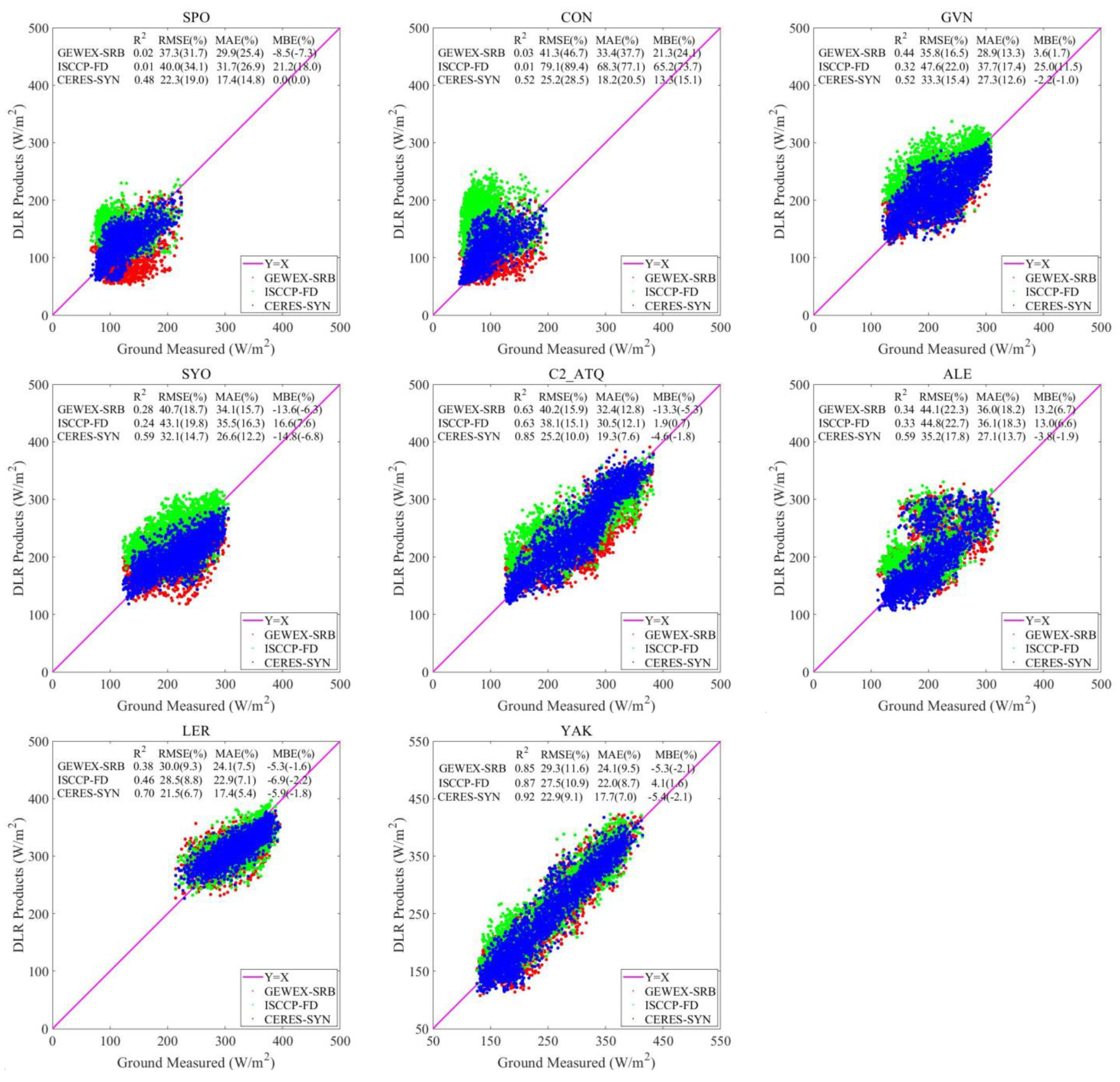
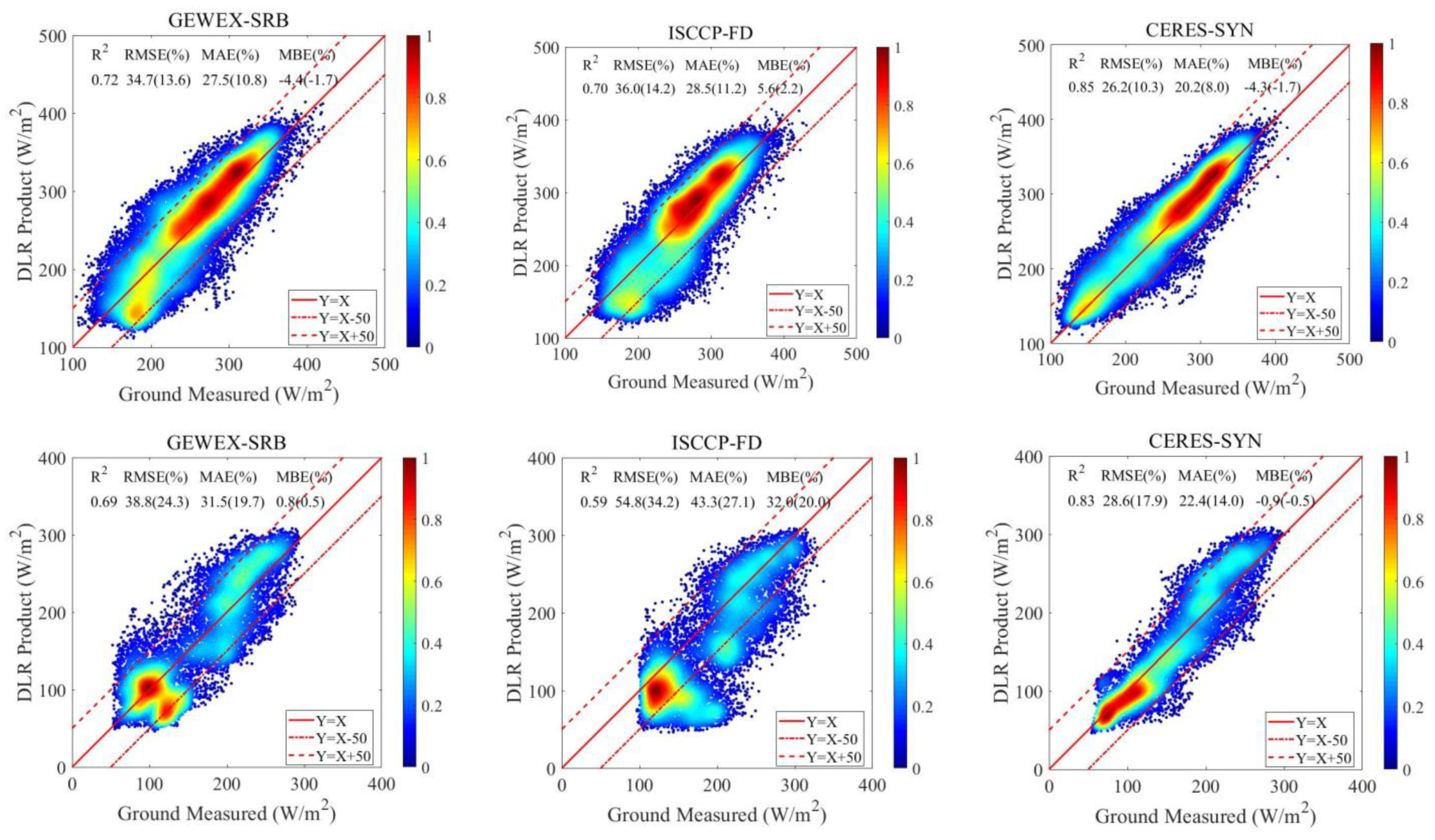
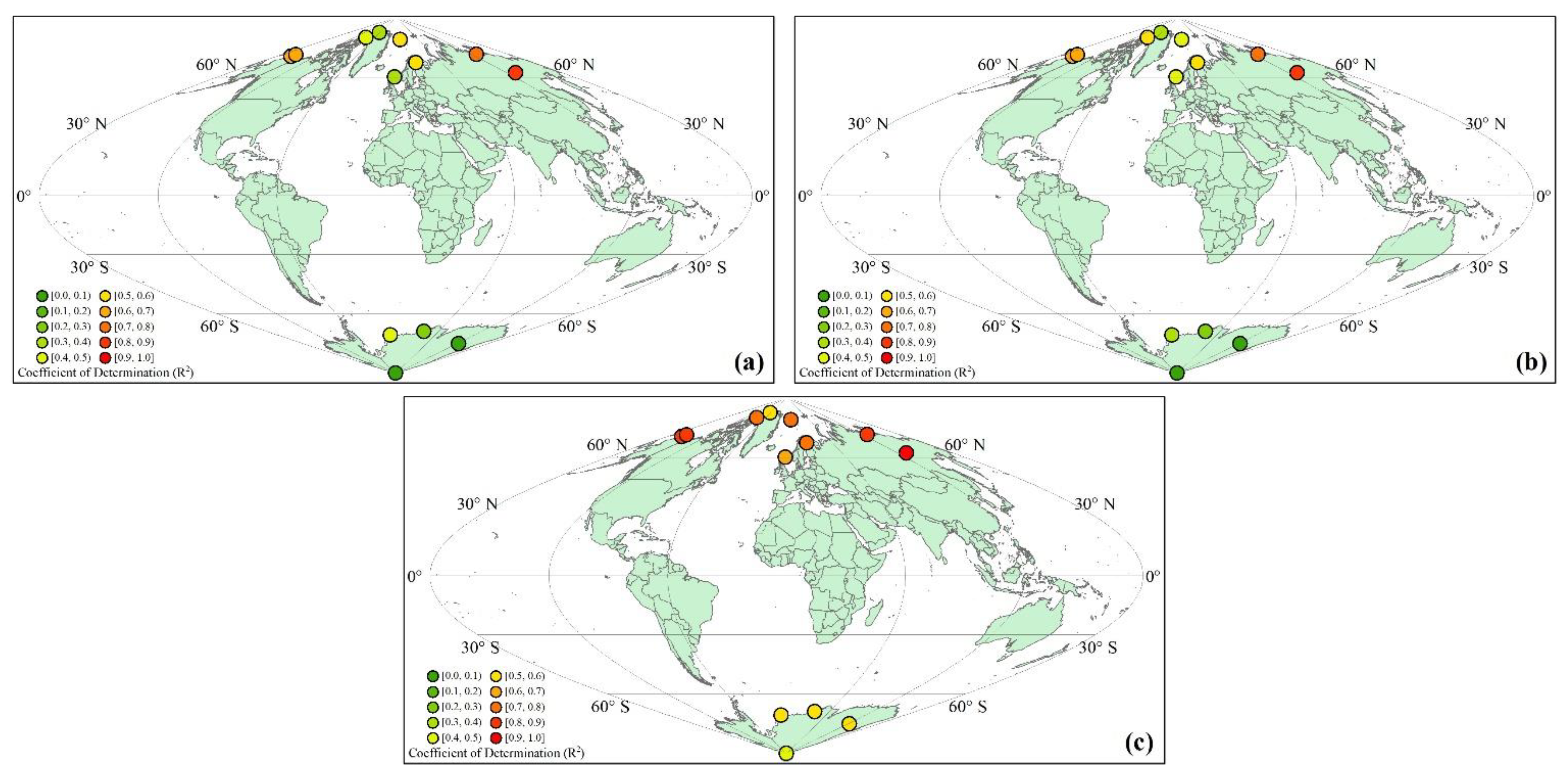
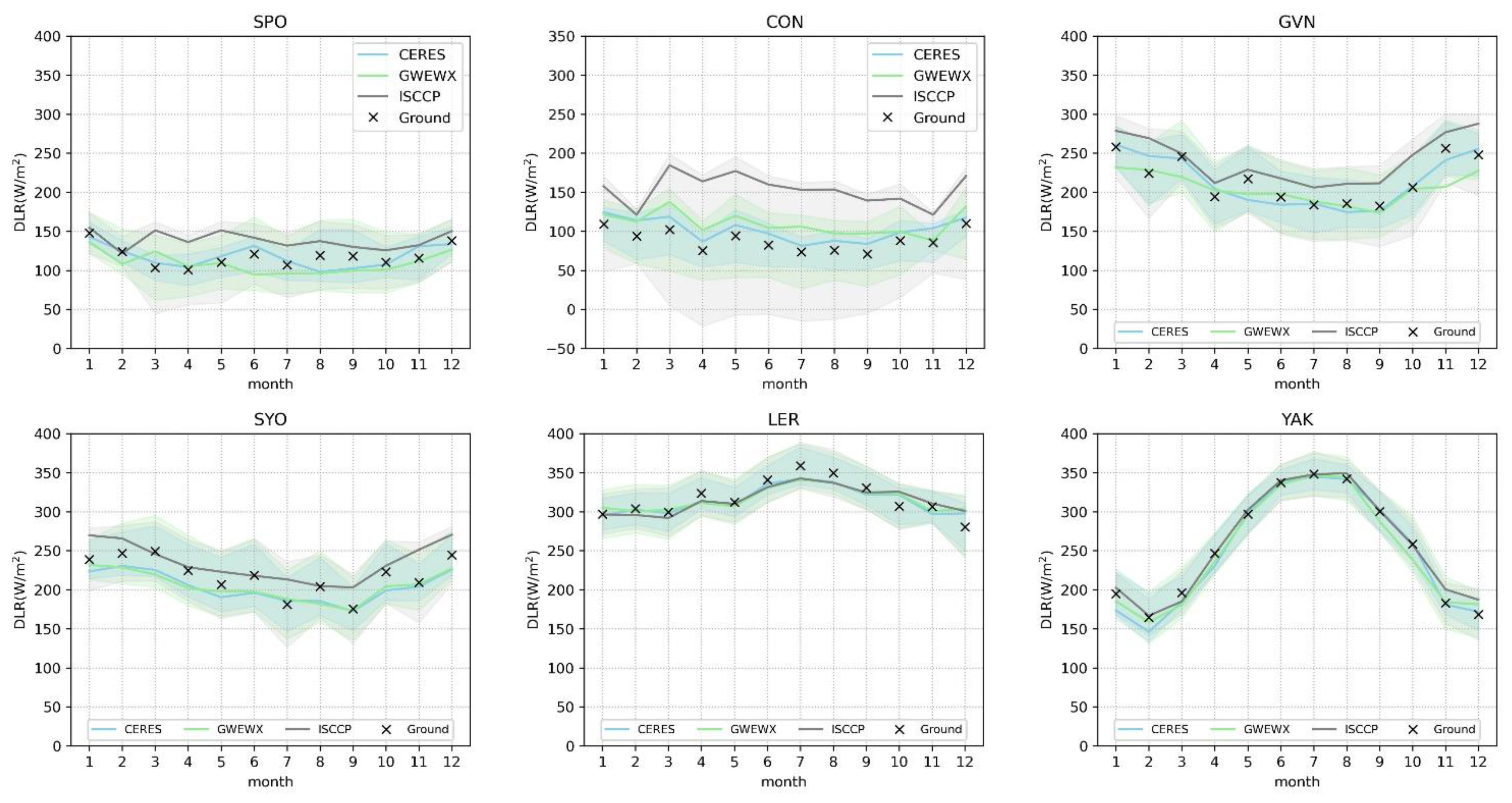
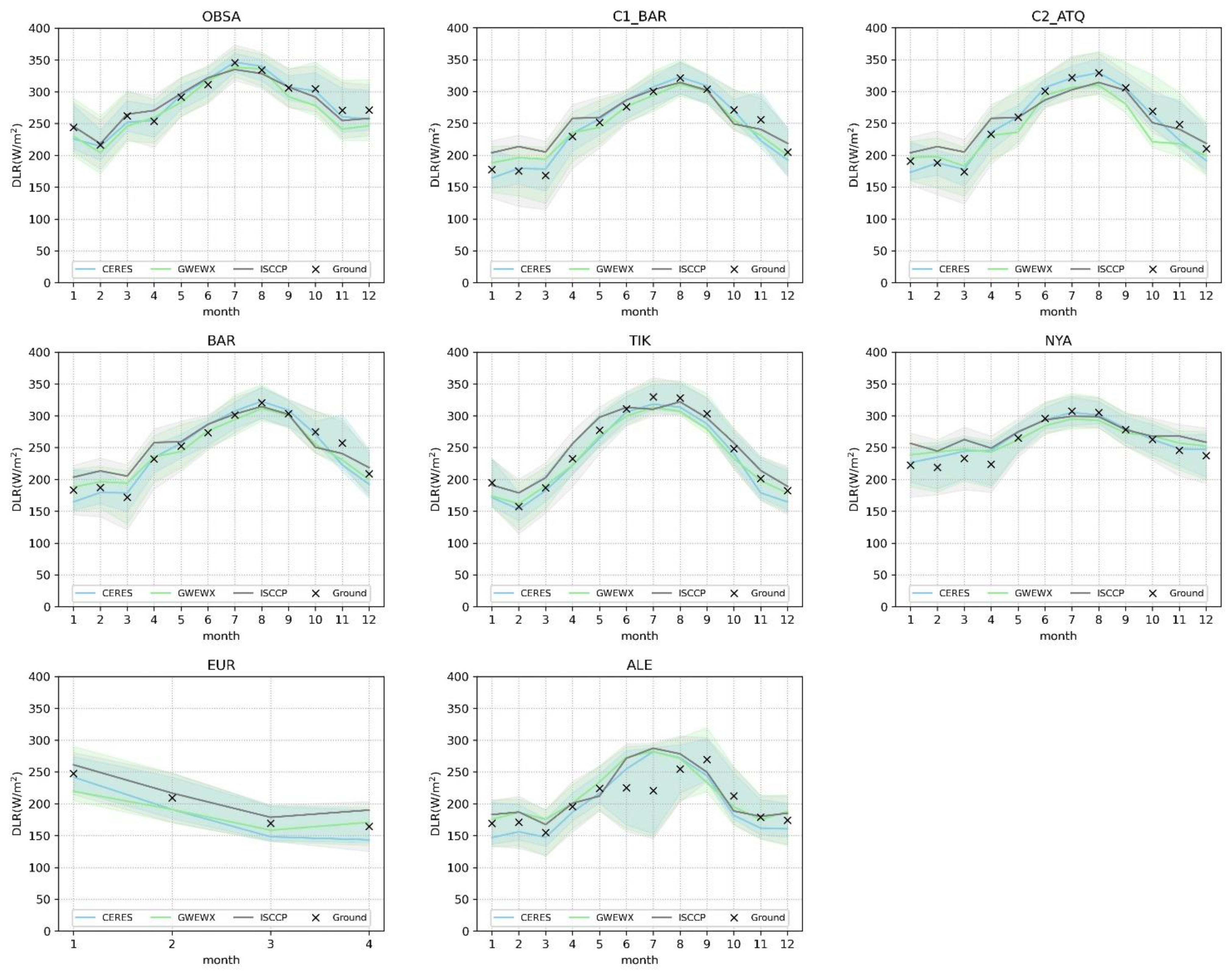
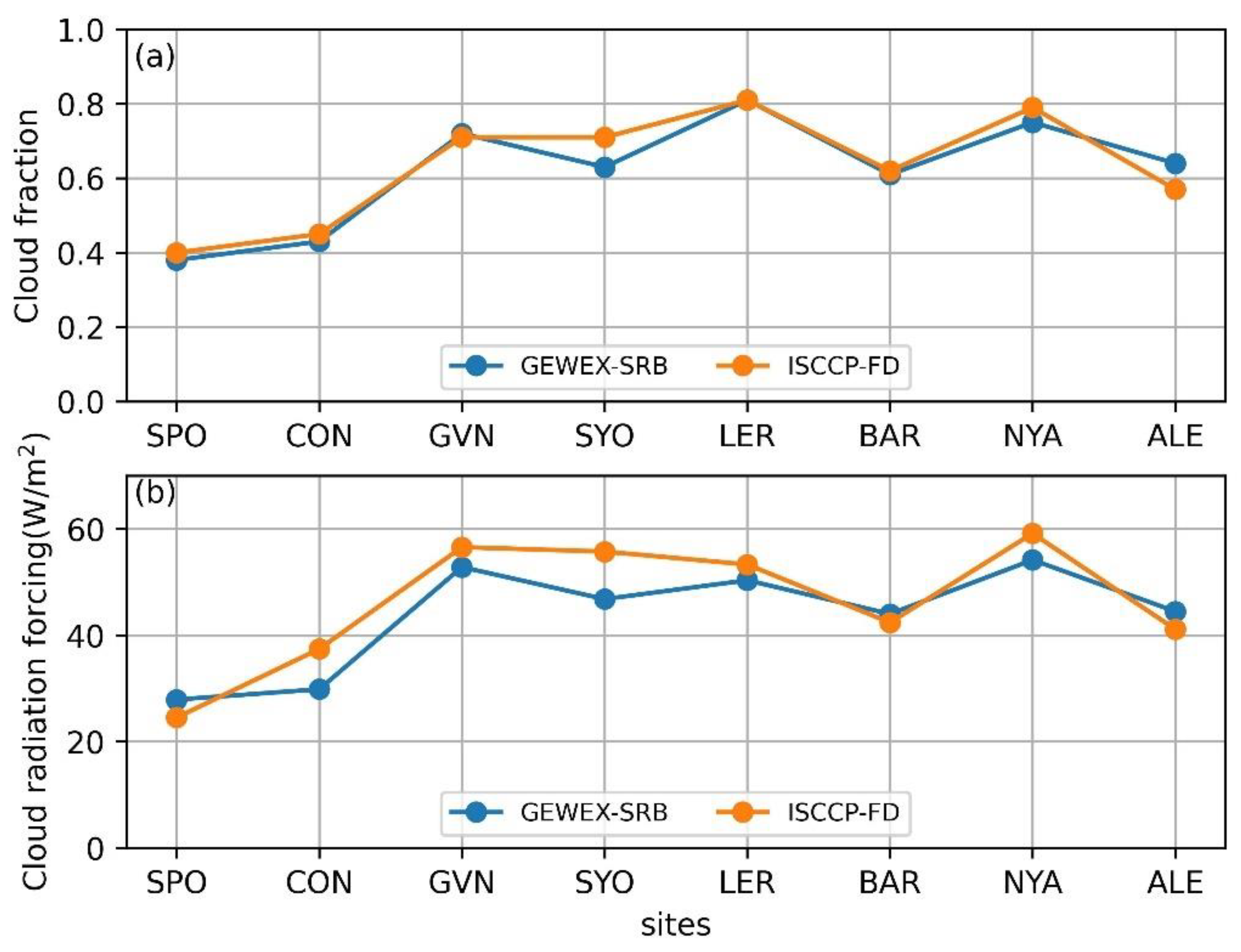



| Product Name | Spatial Resolution | Temporal Resolution | Versions | Time Range |
|---|---|---|---|---|
| GEWEX-SRB | 1° × 1° | 3 h | Release 3.1 | 1983~2007 |
| ISCCP-FD | 2.5° × 2.5° | 3 h | Stage D | 1983~2009 |
| CERES-SYN | 1° × 1° | 3 h | CER_SYN1deg-3Hour_ Edition3A | 1998~Now |
| Site | Latitude (°) | Longitude (°) | Altitude (m) | Time Interval |
|---|---|---|---|---|
| South Pole b (SPO) | −89.983 | −24.799 | 2800 | 1 min |
| Concordia Station b (CON) | −75.100 | 123.383 | 3233 | 1 min |
| Georg Von Neumayer b (GVN) | −70.650 | −8.250 | 42 | 1 min |
| Syowa b (SYO) | −69.005 | 39.589 | 18 | 1 min |
| Lerwick b (LER) | 60.133 | −1.183 | 84 | 1 min |
| Yakutsk c (YAK) | 62.255 | 129.618 | 220 | 30 min |
| ObservatorSiteAc (OBSA) | 67.367 | 26.629 | 179 | 30 min |
| C2_Atqasuk c (C2_ATQ) | 70.472 | −157.407 | 20 | 30 min |
| C1_Barrow c (C1_BAR) | 71.323 | −156.607 | 8 | 30 min |
| Barrow b (BAR) | 71.323 | −156.607 | 8 | 1 min |
| Tiksi c (TIK) | 71.617 | 128.75 | 38 | 30 min |
| Ny-Alesund b (NYA) | 78.925 | 11.930 | 11 | 1 min |
| Eureka b (EUR) | 79.989 | −85.941 | 85 | 1 min |
| Alert b (ALE) | 82.490 | −62.420 | 127 | 1 min |
| Site | GEWEX-SRB | ISCCP-FD | CERES-SYN | |||||||||
|---|---|---|---|---|---|---|---|---|---|---|---|---|
| R2 | RMSE | MAE | MBE | R2 | RMSE | MAE | MBE | R2 | RMSE | MAE | MBE | |
| SPO | 0.02 | 37.3 | 29.9 | −8.5 | 0.01 | 40.0 | 31.7 | 21.1 | 0.48 | 22.3 | 17.4 | 0.0 |
| CON | 0.03 | 41.3 | 33.4 | 21.3 | 0.01 | 79.1 | 68.3 | 65.2 | 0.52 | 25.2 | 18.2 | 13.3 |
| GVN | 0.44 | 35.8 | 28.9 | 3.6 | 0.32 | 47.6 | 37.7 | 25.0 | 0.52 | 33.3 | 27.3 | −2.2 |
| SYO | 0.28 | 40.7 | 34.1 | −13.6 | 0.24 | 43.1 | 35.5 | 16.6 | 0.59 | 32.1 | 26.6 | −14.8 |
| LER | 0.38 | 30.0 | 24.1 | −5.3 | 0.46 | 28.5 | 22.9 | −6.9 | 0.7 | 21.5 | 17.4 | −5.9 |
| YAK | 0.85 | 29.3 | 24.1 | −5.3 | 0.87 | 27.5 | 22.0 | 4.1 | 0.92 | 22.9 | 17.7 | −5.4 |
| OBSA | 0.56 | 37.4 | 29.5 | −11.6 | 0.53 | 35.6 | 28.9 | −1.6 | 0.78 | 24.7 | 19.0 | −3.2 |
| C2_ATQ | 0.63 | 40.2 | 32.4 | −13.3 | 0.63 | 38.1 | 30.5 | 1.9 | 0.85 | 25.2 | 19.3 | −4.6 |
| C1_BAR | 0.68 | 34.0 | 26.6 | −1.0 | 0.61 | 39.1 | 30.5 | 9.7 | 0.82 | 26.4 | 20.2 | −1.2 |
| BAR | 0.68 | 32.7 | 25.6 | −3.3 | 0.61 | 36.7 | 28.7 | 7.9 | 0.81 | 27.0 | 20.8 | −3.5 |
| TIK | 0.80 | 31.7 | 26.3 | −10.8 | 0.73 | 34.8 | 28.5 | 6.1 | 0.89 | 25.7 | 20.7 | −12.6 |
| NYA | 0.59 | 31.2 | 24.1 | 4.9 | 0.48 | 37.4 | 29.4 | 12.8 | 0.73 | 26.1 | 20.1 | 5.5 |
| EUR | 0.45 | 35.5 | 28.0 | −12.5 | 0.51 | 35.2 | 28.2 | 14.1 | 0.76 | 28.2 | 23.3 | −16.7 |
| ALE | 0.34 | 44.1 | 36.0 | 13.2 | 0.33 | 44.8 | 36.1 | 13.0 | 0.59 | 35.2 | 27.1 | −3.8 |
| All mean | 0.48 | 35.8 | 28.8 | −3.0 | 0.45 | 40.5 | 32.8 | 13.5 | 0.71 | 26.9 | 21.1 | −3.9 |
| Sites | Ta (K) | PW (cm) | ||
|---|---|---|---|---|
| MAE | MBE | MAE | MBE | |
| SPO | 27.12 | 27.09 | 0.07 | 0.07 |
| GVN | 10.88 | 10.72 | 0.13 | 0.09 |
| BAR | 8.08 | 7.91 | 0.31 | 0.30 |
| NYA | 3.60 | 2.23 | 0.15 | 0.09 |
| ALE | 4.43 | 0.64 | 0.15 | 0.07 |
| C2_ATQ | 7.05 | 5.40 | 0.22 | 0.14 |
| OBSA | 5.04 | 3.16 | 0.34 | 0.30 |
| C1_BAR | 6.60 | 6.04 | 0.23 | 0.19 |
| YAK | 6.31 | 5.07 | 0.32 | 0.29 |
| TIK | 6.62 | 5.35 | 0.22 | 0.19 |
| Site | R2 | RMSE | MAE | MBE | |||
|---|---|---|---|---|---|---|---|
| W/m2 | % | W/m2 | % | W/m2 | % | ||
| C2_ATQ | 0.63 | 38.0 | 15.06 | 30.53 | 12.07 | 1.87 | 0.74 |
| C1_BAR | 0.61 | 39.06 | 15.95 | 30.51 | 12.46 | 9.72 | 3.97 |
| AVE | 0.65 | 35.97 | 14.46 | 27.92 | 11.23 | 5.86 | 2.35 |
Publisher’s Note: MDPI stays neutral with regard to jurisdictional claims in published maps and institutional affiliations. |
© 2022 by the authors. Licensee MDPI, Basel, Switzerland. This article is an open access article distributed under the terms and conditions of the Creative Commons Attribution (CC BY) license (https://creativecommons.org/licenses/by/4.0/).
Share and Cite
Xin, X.; Yu, S.; Sun, D.; Zhang, H.; Li, L.; Zhong, B. Assessment of Three Satellite-Derived Surface Downward Longwave Radiation Products in Polar Regions. Atmosphere 2022, 13, 1602. https://doi.org/10.3390/atmos13101602
Xin X, Yu S, Sun D, Zhang H, Li L, Zhong B. Assessment of Three Satellite-Derived Surface Downward Longwave Radiation Products in Polar Regions. Atmosphere. 2022; 13(10):1602. https://doi.org/10.3390/atmos13101602
Chicago/Turabian StyleXin, Xiaozhou, Shanshan Yu, Daozhong Sun, Hailong Zhang, Li Li, and Bo Zhong. 2022. "Assessment of Three Satellite-Derived Surface Downward Longwave Radiation Products in Polar Regions" Atmosphere 13, no. 10: 1602. https://doi.org/10.3390/atmos13101602





